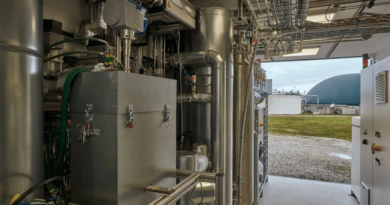Cleanroom in the industry – a connection between design and technology
For rooms to be clean and sterile stacking them up with technology equipment is not enough. A more important stage is the first one – quality design, ensuring not only compliance with established cleanliness requirements or a process but also the fact that the designed systems become reliable, easy to maintain, sustainable and safe.
FOCUS ON QUALITY OF DESIGN
The stage of design always opens with the client’s (builder’s) task. As trends of manufacturing technology, requirements for products and their environment are not the same in different industries (pharmacy, biotechnology, electronics etc.), cleanroom alone can have different requirements and design nuances. For example, while the level of microbiology in air or on surfaces is not controlled in the field of electronics, for the industries of biotechnology or pharmacy this indicator is the major one. Thus, in such cases it is important to ensure the lowest possible risk.
In the stage of design, technical task is of great importance, as the completeness thereof defines project complexity, scope, price and operation costs throughout the life cycle of an object. The task usually describes such requirements as conceptual layout of the rooms, bearing in mind migration of the products from the beginning of its manufacturing process until the final stage, migration of staff, purpose of the rooms and their class of cleanliness. Overpressures of the rooms and adequate arrangement of overpressures cascades among the rooms (thereby the direction of air movement is controlled). Microclimate requirements for the rooms (temperature, relative humidity), as some products might be sensitive to temperature and humidity. Necessary engineering communications and other requirements (e.g. regarding illumination, types of surface materials, monitored parameters of microclimate of the rooms or equipment, building management systems (BMS) etc.).
In some cases the location of cleanroom facilities in the city is important: for example, in the biotechnology industry usually some processes and products cannot be close to other processes and products, as they can contaminate each other. Then, the rooms are arranged as far as possible from each other, and different equipment is used for their ventilation, other engineering solutions are taken into account in order to reduce the risk to the lowest possible extent.
Besides, modular cleanrooms are not popular in Lithuania, as all microclimate parameters, overpressures need to be maintained there, finally, cleanrooms are arranged in Lithuania for long-term operation. Attractive characteristics of modular cleanrooms could be lower price, easy installation and removal.
PREVAILING CHOICE – STAINLESS STEEL
Cleaning of empty rooms is the easiest, where all surface are easily accessible, therefore the cleanest rooms are those with least of things and smooth surfaces. In cleanroom it is attempted to round steep angles as much as possible in order to gain easier access to necessary spots and clean them or disinfect, while all small connections are usually sealed (open engineering systems are designed to a minimum extent, places where the existing engineering systems cross the partition must be sealed).
Such solutions reduce the possibility for microorganisms to grow in small cracks, and, at the same time, increase tightness of the rooms. All surfaces of the rooms must be resistant to chemicals which are used for cleaning and disinfection of the rooms. In the industry of biotechnology or pharmacy, furniture and their surfaces are usually made of stainless steel.
When designing working surfaces, usually the type of industry is taken into consideration. Furniture made of stainless steel prevail in the industry of pharmacy or biotechnology because of their antibacterial properties. In these industries furniture must be as smooth as possible and have as few as possible places which are hard to reach when cleaning or disinfecting. In the industry of electronics or lasers working surfaces usually are made of particle boards, however, in those places where lasers are tested, different requirements apply, as some materials, for example, plastic can melt when it is exposed to lasers.
SUBDIVISION INTO NINE CLASSES
Cleanrooms are subdivided into classes according to highest concentration of particles permitted per volume of air (per one cubic metre of air. The size of particles in air is, accordingly, equal to 0,5 μm, 5,0 μm or more). According to standard ISO 14644-1:2015, cleanrooms are subdivided into nine classes (ISO 1, ISO 2, ISO 5 etc.). The strictest requirements are established for rooms of ISO class I. It is recommended to install one-direction air flow systems for rooms attributed to ISO 5 and a higher class (laminar air flow the direction whereof is vertical or horizontal).
Besides, even though the number of particles in the air is the main criterion when establishing a class of cleanroom, however in order to reach the desired air purity in the room it is necessary to make a lot of “homework”: to arrange sealed rooms which are easy to clean, to ensure necessary air change rate in the rooms, install air filtering, cleaning and disinfecting measures (for example, additional filters in the ventilation equipment, HEPA filters in cleanrooms, UV lamps). Install air distribution systems (air supply and discharge) so that these could efficiently eliminate air contamination occurring in cleanrooms (due to people, manufacturing processes, equipment used in cleanroom facilities). To maintain necessary air pressure differences among individual rooms, that is, to ensure proper air flow directions in cleanrooms: the air must move from cleaner zones towards the more contaminated ones. To ensure necessary microclimate parameters in rooms (air temperature, relative humidity).
Cleanrooms are certified in several stages: it is inspected whether the design of cleanrooms is in compliance with the task prepared by the client for arrangement of clean premises, whether the mounted equipment (systems) are in compliance with the approved design, remote BMS controlling operation of the main engineering systems in cleanrooms. Measurements are made in cleanrooms: regarding the amount of supplied or discharged air, difference in air pressures (overpressures) among cleanrooms, inspection of tightness or contamination of HEPA filters, inspection of speed of air flow directions or self-cleaning of rooms, inspection of particles in air, measurements of bacteria growth (in air or on surfaces). Other measurements are made as well: air temperature, relative humidity, noise, illumination.
Having performed certification of cleanrooms, periodical inspection of operating engineering systems and the main air parameters is carried out according to the work schedule approved by the client.
Cleanrooms are arranged with a purpose to work in controlled environment where the desired air cleanliness would be guaranteed. Cleanrooms may be arranged for laboratories of various purposes. Such facilities are mostly relevant to the industry of biotechnology, electronics, IT, pharmacy, health treatment institutions (surgery rooms), manufacturing of optical instruments, nanotechnology.
IMPACT OF VENTILATION ON THE QUALITY OF FACILITIES
Ventilation and air conditioning systems are one of the most important components of cleanrooms, as in absence of relevant air change and filtering system it is impossible to meet the requirements established for cleanrooms. Air preparation (heating, cooling, humidifying) systems can not be a source of contamination, therefore the processed air of needed parameters is supplied to cleanrooms. Supplied or discharged air is prepared in ventilation assemblies. Ventilation equipment ensures the necessary air change, supplies filtered air, discharges the air exposed to local contamination sources, maintains the parameters of air temperature, relative humidity set in cleanrooms).
Due to relatively high air flows (if compared to the regular ventilation systems), usually the equipment for ventilation of cleanrooms works with a partial air mixing, that is, the fresh air flow accounts for 15-30%, whereas the remaining portion – filtered air flow discharged from rooms. Thereby, energy costs for air preparation processes are reduced. Under favourable conditions outside the facilities (proper air temperature and humidity for direct supply of air to facilities), the ratio of air mixing may be modified. When it is exposed to products which are potentially hazardous to people in cleanrooms, separate systems are used for air discharge – fume hoods. In this case, the discharged air cannot mix directly with the air flow which is supplied directly to the rooms.
CLEANLINESS OF ROOMS DEPENDS ON THE FOLLOWING:
• employees’ clothing and their work culture (compliance with procedures);
• layout of rooms and sluices;
• ventilation system (air change, maintenance of overpressures among rooms, filters and layout of distributors);
• quality of cleaning and disinfection services;
• additional measures, for example, UV lamps;
• manufacturing processes taking place;
• materials of surfaces and equipment in the facilities, as some materials or equipment may generate particles by themselves;
• communications located in the facilities, for example, sewage, compresses air etc. They can also be sources of contamination.




